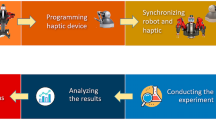Abstract
Usability and user acceptance play an important role in the development of new systems. In the present study, a new generation of laser control software from TRUMPF Laser GmbH was evaluated regarding its usability and acceptance in a formative remote usability test. Because change processes, such as software relaunches, can lead to a change in the subjectively perceived competence of users, the study focusses on evaluating differences between two competence groups (“low competence” and “high competence” in operating the current laser control software; N = 35). Basic interactions on the prototype of the new generation of laser control software were tested in seven tasks. The results of the study show that the two competence groups do not differ significantly in their performance or acceptance. However, it could also be shown that users with different prior knowledge should be supported differently when transitioning to the new software.
Access this chapter
Tax calculation will be finalised at checkout
Purchases are for personal use only
Similar content being viewed by others
References
TRUMPF GmbH + Co. KG (Holding): Trumpf Internal Website (2020). https://www.trumpf.com/de_INT/
Shneiderman, B., Plaisant, C., Cohen, M., Jacobs, S., Elmqvist, N.: Designing the User Interface: Strategies for Effective Human-Computer Interaction, Global Edition. Pearson Education Limited, Harlow (2017)
Ullrich, A., Vladova, G., Thim, C., Gronau, N.: Organisationaler Wandel und Mitarbeiterakzeptanz. Vorgehen und Handlungsempfehlungen. [Organisational change and employee acceptance. Procedure and recommendations for action] In: Obermaier, R. (ed.) Handbuch Industrie 4.0 und Digitale Transformation [Handbook Industry 4.0 and Digital Transformation], pp. 565–587. Springer Fachmedien Wiesbaden, Wiesbaden (2019). https://doi.org/10.1007/978-3-658-24576-4_23
Ullrich, A., Vladova, G., Thim, C., Gronau, N.: Akzeptanz und Wandlungsfähigkeit im Zeichen der Industrie 4.0 [Acceptance and transformability under the sign of Industry 4.0]. HMD, vol. 52, pp. 769–789 (2015). https://doi.org/10.1365/s40702-015-0167-8
Wiendick, G.: Akzeptanz [Acceptance]. In: Frese, E. (ed.) Handwörterbuch der Organisation. Enzyklopädie der Betriebswirtschaftslehre [Hand dictionary of organisation. Encyclopaedia of Business Administration], vol. 2, pp. 89–98. Schäffer-Poeschel, Stuttgart (1992)
Vogelsang, K., Steinhüser, M., Hoppe, U.: Theorieentwicklung in der Akzeptanzforschung: Entwicklung eines Modells auf Basis einer qualitativen Studie [Theory development in acceptance research: development of a model based on a qualitative study]. In: Wirtschaftsinformatik [Business Informatics] (2013)
Dillon, A.: User acceptance of information technology Encyclopedia of Human Factors and Ergonomics. Taylor and Francis, London (2001)
Gill, R.: Change management–or change leadership? J. Chang. Manag. 3, 307–318 (2002). https://doi.org/10.1080/714023845
Doppler, K., Lauterburg, C.: Change Management. Den Unternehmenswandel gestalten [Shaping corporate change]. Campus Verlag, Frankfurt (2019)
Landes, M., Steiner, E.: Psychologische Auswirkungen von Change Prozessen: Widerstände, Emotionen, Veränderungsbereitschaft und Implikationen für Führungskräfte [Psychological effects of change processes: resistance, emotions, readiness to change and implications for managers]. In: Landes, M., Steiner, E. (eds.) Psychologie der Wirtschaft [Psychology of the economy], pp. 721–750. Springer Fachmedien Wiesbaden, Wiesbaden (2013). https://doi.org/10.1007/978-3-531-18957-4_34
Rafferty, A.E., Griffin, M.A.: Perceptions of organizational change: a stress and coping perspective. J. Appl. Psychol. 91, 1154–1162 (2006). https://doi.org/10.1037/0021-9010.91.5.1154
Roth, S.: Emotionen im Visier: Neue Wege des Change Management [Focusing on emotions: New ways of change management] (2000)
TRUMPF Laser GmbH (Pfeifle, Erik): Internal Findings. Berlin (2020)
Dreyfus, S.E., Dreyfus, H.L.: A five-stage model of the mental activities involved in directed skill acquisition (1980). https://apps.dtic.mil/dtic/tr/fulltext/u2/a084551.pdf
Dreyfus, S.E.: The five-stage model of adult skill acquisition. Bull. Sci. Technol. Soc. 24, 177–181 (2004). https://doi.org/10.1177/0270467604264992
Figma. Figma Inc. (2015)
Maze. Maze.design Limited, Faversham, United Kingdom (2018). https://www.notion.so/Press-Kit-421d405e76154662a547ce9ef2a3f018
DIN Deutsches Institut für Normung e. V.: Ergonomie der Mensch-System-Interaktion - Teil 210: Menschzentrierte Gestaltung interaktiver Systeme [Ergonomics of human-system interaction - Part 210: Human-centred design of interactive systems] (ISO 9241-210:2019); Deutsche Fassung EN ISO 9241-210:2019 (DIN EN ISO 9241–210). Beuth Verlag GmbH, vol. 13.180, 35.180 (2020)
Rummel, B.: System Usability Scale – jetzt auch auf Deutsch [- now also in German] (2016). https://blogs.sap.com/2016/02/01/system-usability-scale-jetzt-auch-auf-deutsch/
Brooke, J.: SUS: a ‘quick and dirty’ usability scale. In: Jordan, P.W., Thomas, B., McClelland, I.L., Weerdmeester, B. (eds.) Usability Evaluation in Industry, pp. 189–194. CRC Press (1996)
van der Laan, J.D., Heino, A., de Waard, D.: A simple procedure for the assessment of acceptance of advanced transport telematics. Transp. Res. Part C Emerg. Technol. 5, 1–10 (1997). https://doi.org/10.1016/S0968-090X(96)00025-3
Kondzior, M.: Akzeptanzskala: Methode zur Erfassung der Akzeptanz eines Systems [Acceptance scale: Method for recording the acceptance of a system] (n.d.). http://www.hfes-europe.org/accept/accept_de.htm
Author information
Authors and Affiliations
Corresponding author
Editor information
Editors and Affiliations
Rights and permissions
Copyright information
© 2022 The Author(s), under exclusive license to Springer Nature Switzerland AG
About this paper
Cite this paper
Schwaiger, L., Radziwill, M., Wagner-Hartl, V. (2022). Relaunch of an Industrial Laser Control Software – Influence of Perceived Competence on Usability and Acceptance. In: Stephanidis, C., Antona, M., Ntoa, S. (eds) HCI International 2022 Posters. HCII 2022. Communications in Computer and Information Science, vol 1580. Springer, Cham. https://doi.org/10.1007/978-3-031-06417-3_17
Download citation
DOI: https://doi.org/10.1007/978-3-031-06417-3_17
Published:
Publisher Name: Springer, Cham
Print ISBN: 978-3-031-06416-6
Online ISBN: 978-3-031-06417-3
eBook Packages: Computer ScienceComputer Science (R0)




